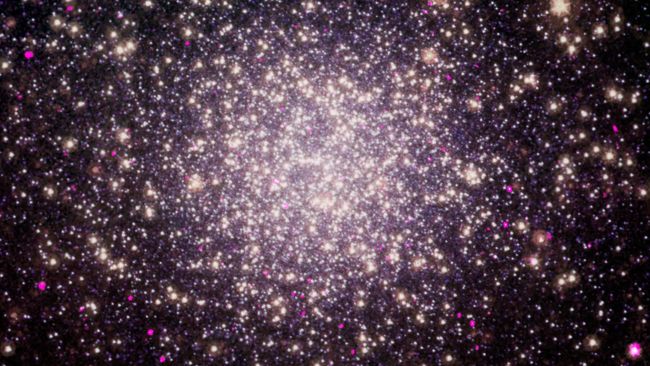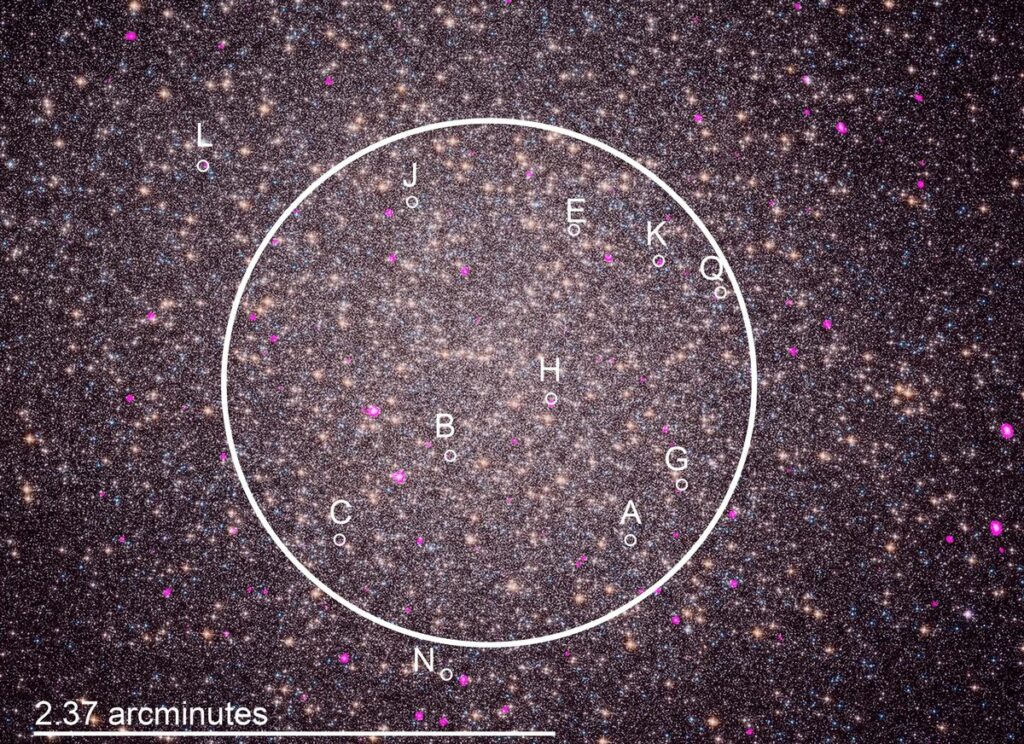X-ray Telescope Captures ‘Spider Pulsars’ Engulfing Stars Similar to Cosmic Black Widows (Image)
A group of rapidly rotating neutron stars is causing the evaporation of nearby stars, a phenomenon observed by the Chandra X-ray Space Telescope.

NASA’s Chandra X-ray Observatory, situated in space, has observed a group of spider pulsars consuming their companion stars within the globular cluster Omega Centauri. This data could significantly contribute to scientists’ comprehension of how these rapidly rotating neutron stars, named after arachnids due to their consumption of their mates, impact nearby stars through intense radiation beams.
The five spider pulsars in this cluster—referred to as a “clutter,” analogous to a closely grouped gathering of spiders—were discovered concentrated at the core of Omega Centauri, an extensive assembly of approximately 10 million stars located 17,700 light-years away from Earth. Initially uncovered by scientists using the Parkes and MeerKAT radio telescopes, a total of 18 rapidly spinning neutron stars, or “millisecond pulsars,” were identified.
Researchers from the University of Alberta in Canada identified the quintet of spider pulsars in radio telescope data after noticing that 11 out of the 18 were emitting X-ray radiation. This discovery signaled that something noteworthy was happening. In an effort to enhance the understanding of these cosmic black widow analogs, the team compared the radio data of the pulsars with Chandra X-ray observations of 26 spider pulsars situated in 12 other globular clusters.
“Hatching” from dead stars
Similar to all neutron stars, spider pulsars originate when massive stars deplete their fuel, ceasing nuclear fusion in their cores. This marks the conclusion of the outward energy flow that had counteracted the gravitational pressure for millions or even billions of years.
Following the supernova explosions that propel the outer layers of the dying star outward, the stellar cores, possessing masses between one and two times that of the sun, swiftly collapse to a diameter of approximately 12 miles (20 kilometers). This collapse compels electrons and protons to merge, forming an incredibly dense sea of neutrons—neutral particles typically found at the atomic core. The density is so extreme that a tablespoon of it would weigh over 1 billion tons (900 billion kilograms), equivalent to the weight of Mount Everest.
Beyond conferring the “neutron” element to their name, this collapse yields two noteworthy outcomes. Similar to a figure skater pulling in their arms to increase their spin, the swift reduction in the radius of these deceased stellar cores accelerates their rotation, enabling some to spin hundreds of times per second, resulting in millisecond pulsars. Certain millisecond pulsars even achieve rotation rates as high as 700 times per second.
Moreover, the gravitational collapse compels the convergence of magnetic field lines, amplifying the magnetic field strength of neutron stars to thousands of times that of Earth’s magnetic field. Consequently, these magnetic fields emit jets of matter that create radiation beams, akin to “cosmic lighthouses,” sweeping across the universe as the neutron star rotates.
These rotating neutron stars are known as pulsars, and when the emitted radiation beams impact surrounding stars, the phenomenon is labeled “spider pulsars.”
This destructive process is feasible because spider pulsars are typically in close proximity to their companions, at a distance around 14 times that between Earth and the moon. This relatively short separation allows energetic particles emitted by the pulsars to erode their companion stars.
Cosmic redbacks vs. black widows

Spider pulsars are further categorized into two arachnid-themed subgroups based on their prey. “Redback” spider pulsars consume companion stars with masses ranging between 10% and 50% of the sun, while “black widow” spider pulsars target smaller stars with less than 5% of the sun’s mass.
In the recent investigation conducted by the team, the researchers identified another distinction between neutron star redbacks and black widows. They observed that redback pulsars emit brighter X-rays compared to black widow pulsars. This marks the first time a connection has been established between the mass of stars being consumed by spider pulsars and the radiation responsible for their erosion.
This influence is attributed to particles streaming from the pulsars colliding with material winds from companion stars, creating shockwaves that generate X-rays—the radiation contributing to the ongoing erosion of these stars, detected by Chandra’s sensitive X-ray vision. Larger stars seem to generate more X-rays, resulting in redbacks appearing brighter in X-ray light compared to black widows, according to the team’s analysis.
The role of Chandra is pivotal in the exploration of spider pulsars and other millisecond pulsars. Its sensitive X-ray capabilities allow for the differentiation between these pulsars and other X-ray sources within globular clusters—clusters of stars bound by gravity and increasing in density toward a central point. This distinction is particularly crucial in Omega Centauri, where numerous identified millisecond pulsars are closely situated among unrelated X-ray sources.
The team’s research will soon be published in the December edition of the journal The Monthly Notices of the Royal Astronomical Society. A preprint version is available on the paper repository arXiv.
Do not forget to share your opinion with us to provide you with the best posts !



0 Comments